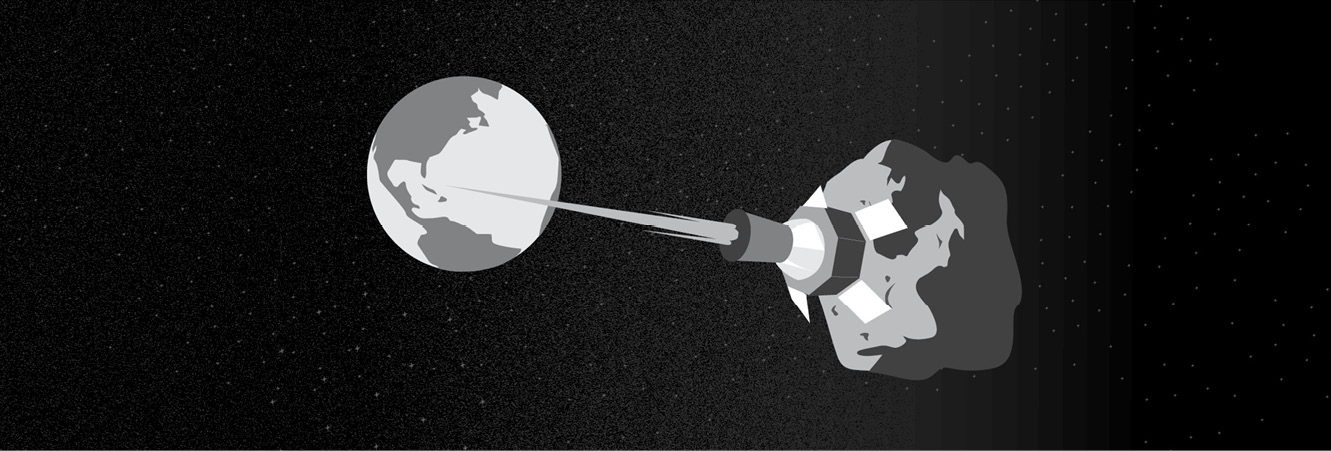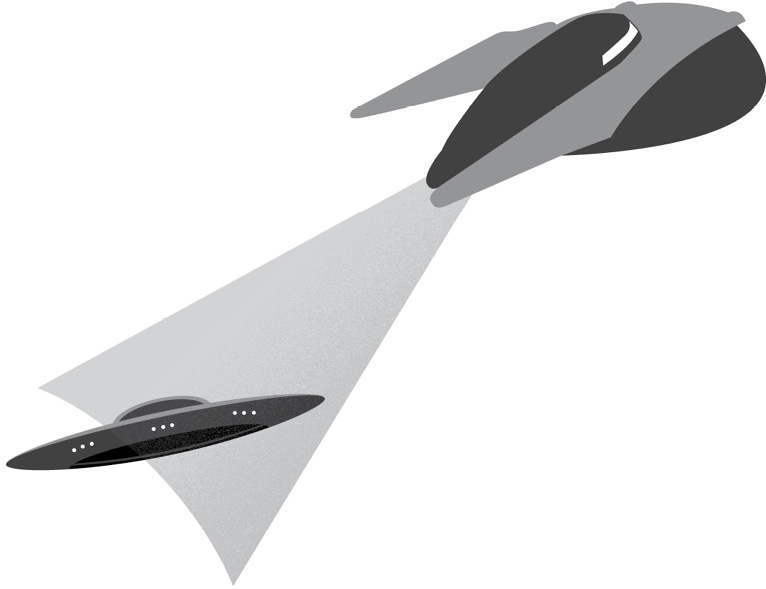24 How Did an Asteroid Wipe Out the Dinosaurs?
Sixty-six million years ago, a visitor from space landed in Mexico. It was a space rock, a flying mountain twelve kilometers across that slammed into the Earth at more than fifty thousand kilometers per hour. The explosion shook the planet, gouged a huge crater fifty kilometers wide into the coast of what is now Chicxulub, Mexico, sent enormous tsunamis racing across the Atlantic Ocean, and set fire to the Earth and the atmosphere.
As a result of the fires and the global cloud cover, acid rain fell from the sky for months after the impact. And because the asteroid kicked up a lot of dust and debris, our planet was very dark for about a year. This darkness and acid destroyed plants, which were food for the big, herbivorous dinosaurs, such as duckbills and ceratopsia, that were roving the planet at that time.

Most of the large dinosaurs—such as the T. rex, triceratops, and duckbilled dinosaurs—couldn’t adapt to the new conditions. They didn’t survive for long after the asteroid impact. But other dinosaurs did. Birds are direct descendants of dinosaurs, and they made it through the experience, along with a number of animals that are familiar to us today—crocodiles, turtles, salamanders, frogs, and, of course, mammals. When the dinosaurs went extinct (at least the big ones on land), mammals took over and diversified within a few million years.
It’s hard to believe that creatures that had been on this planet for 150 million years (much longer than humans have been around) were wiped out by a single rock. But that wasn’t the first time that life on Earth was killed by a large object falling from space. Scientists believe it happened at least four other times before that. In fact, 250 million years ago, long before even the dinosaurs existed, an asteroid wiped out almost all life on our planet, including life in the oceans. That event is known as the “Great Dying.”
But life on Earth did grow back. It was just different from the life that existed before. That new wave gave way to the dinosaurs. After the dinosaurs disappeared, mammals took over, and… well, here we are. In other words: we owe our existence to an asteroid.
Evolution is an essential part of life on Earth. A big change in the environment—whether it’s from something hitting the planet or volcanic activity—occurs every hundred million years or so. So here we are: big, dominant creatures thriving on the planet today. Does that mean we’re the next to go? Is there a giant space rock just waiting to take us out?
Before you panic and go outside screaming about the sky falling, it might help you to know that we have something the dinosaurs didn’t. We have telescopes. We can see asteroids coming toward us. Fortunately, none have been spotted yet that are dangerous. But if one is found, there are several ways we could steer it away so that it doesn’t hit us.
We could send up a nuclear weapon and explode the incoming asteroid, provided we see it years in advance. The problem with this approach is space junk. Even if we blew up the asteroid, lots of smaller bits would still hit the Earth and do serious damage.
A better option is to gently push the asteroid just a little off its course so it will miss the Earth. One way of doing that is to send a spacecraft out to meet it. The spacecraft would use its rocket engine to push on the asteroid and alter its course.

Another idea is to simply hit the asteroid with something heavy. We would have to be careful not to hit it too hard, of course; otherwise we might break it into pieces. We’ve sent out spacecraft to see what asteroids look like close-up, and we found that many of them are made of very loose material, almost like gravel, so they break apart very easily. We could hit the asteroid gently again and again until we nudge it off course. A mission called DART, which stands for Double Asteroid Redirection Test, will try out this idea on a small asteroid.
We could also use explosives to change the asteroid’s course. Again, we wouldn’t want to blow up one big problem into a bunch of smaller ones. But if a large bomb were detonated beside the asteroid instead of right on it, the force of the blast could nudge it off course.

In science fiction, such as Star Trek, a tractor beam is sometimes used to tow a smaller spacecraft into a bigger one. No such beams actually exist, but believe it or not, the same thing can be accomplished using gravity alone. All objects possess gravity, so if a massive spacecraft was parked beside an asteroid, there would be a small gravitational attraction between the two of them. This would normally cause the spacecraft to crash into the asteroid. But if the spacecraft ran its engines and pulled against the asteroid’s gravity and toward itself, the asteroid would be pulled toward the ship. This gravitational tug, while not very strong, would be enough to steer the asteroid off course.
Finally, one of the simplest ways to move an asteroid is to send up a big can of paint and color the whole thing white. No, really, it’s not a joke! Sunlight reflecting off the white paint would push on the asteroid gently, turning the asteroid into a solar sail and altering its course.
SPACE PLACES 
In a desert of Arizona, in the southwestern United States, there is a very large hole in the ground called Meteor Crater. The big circular hole, shaped like a deep salad bowl, is more than a kilometer across and was gouged out by a meteorite the size of a house that crashed to Earth fifty thousand years ago. Since the area is a desert, there has been very little rainfall to wash the crater away, so it is almost perfectly preserved. This is one of the few places on Earth where you can see how much damage an object falling from space can do to the ground.
Now imagine the destruction sixty-six million years ago, when the object that hit the Earth was the size of a mountain. You can see what the dinosaurs were up against!
The most important part of moving an asteroid off its collision course with the Earth is to reach it when it’s really far away. From a great distance, the Earth is a much smaller target, so it doesn’t take much of a push to make the asteroid miss us, the same way that even a small change from a pitcher’s arm can mean the difference between a strike and a ball in baseball. But as the asteroid gets closer, it has to move a much greater distance to get out of the way. That takes a lot more energy. If it’s too close, though, there’s nothing we can do. Earth will have another bad day.
Asteroid impacts are a natural hazard that we could prevent with enough advance notice. That means that, for what may be the first time in our planet’s history, we can prevent an asteroid apocalypse. Too bad the dinosaurs didn’t have that option.